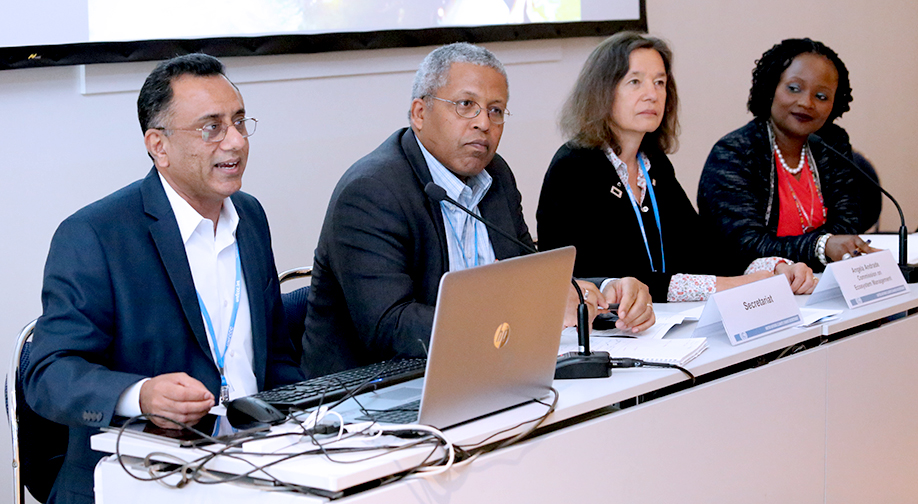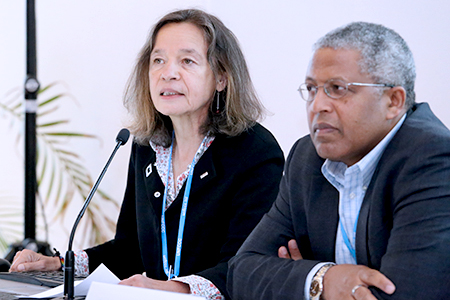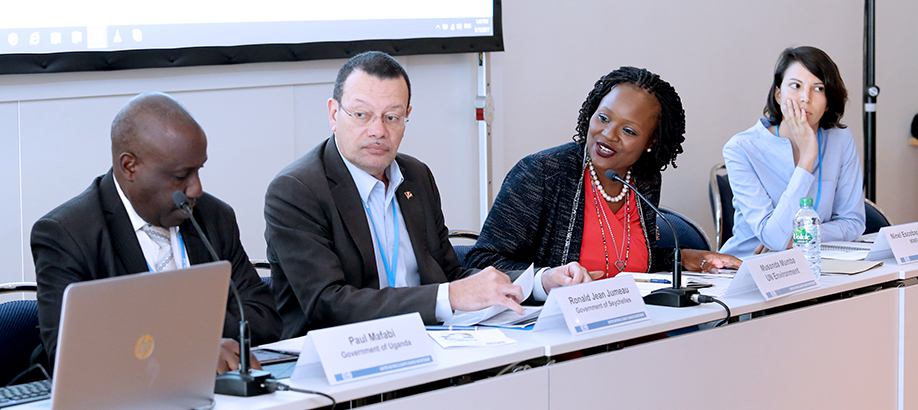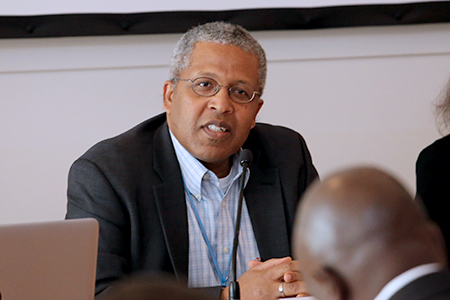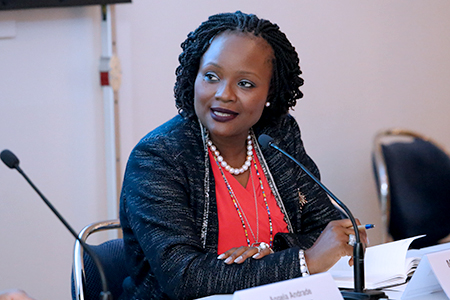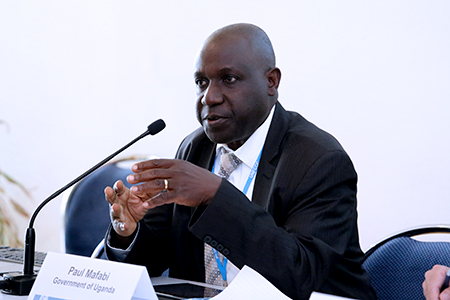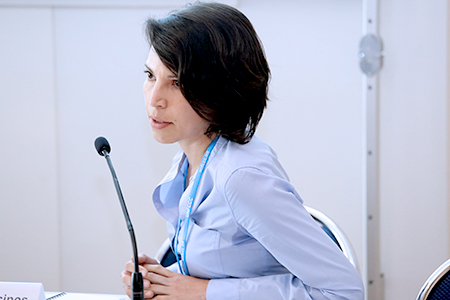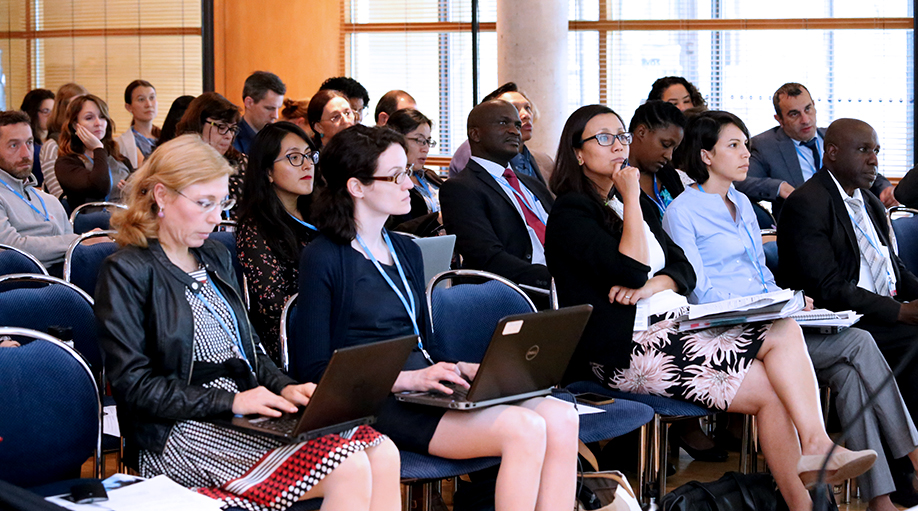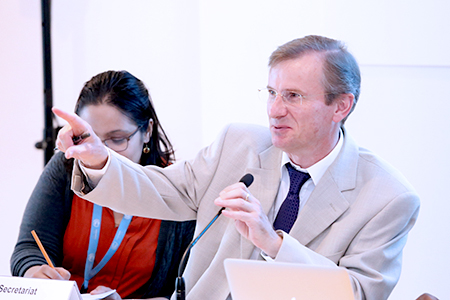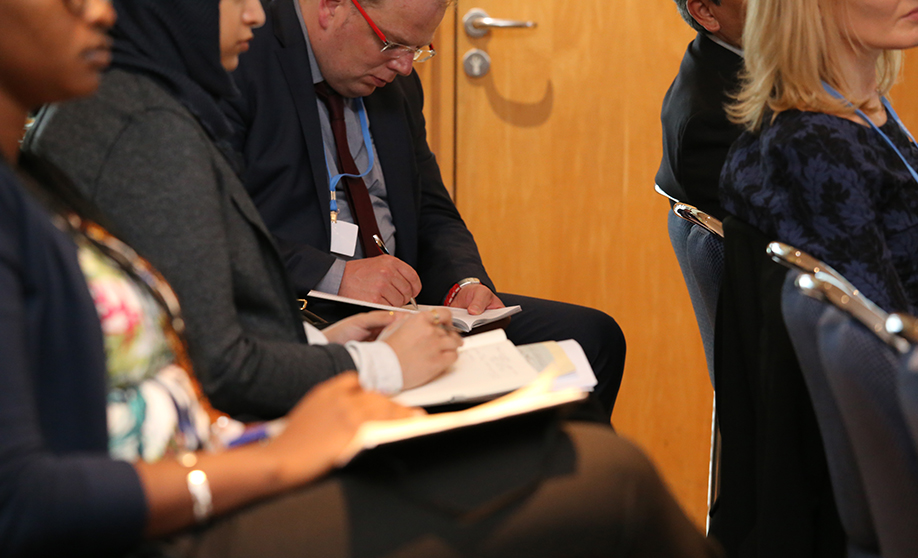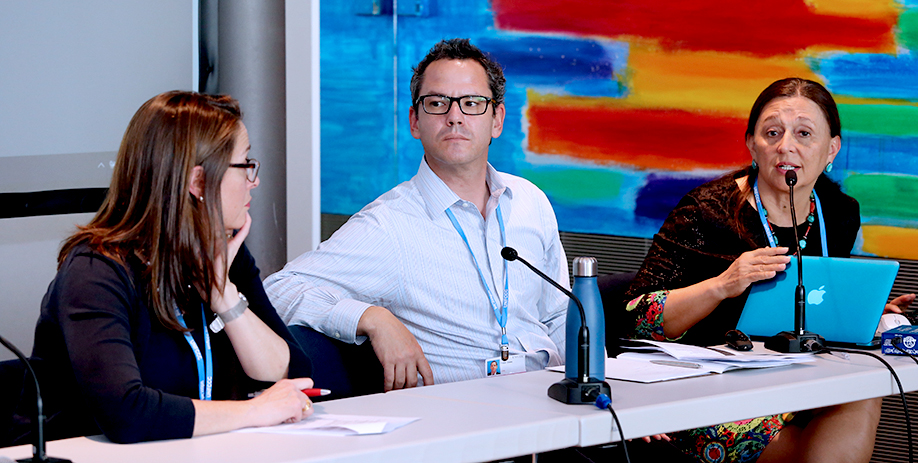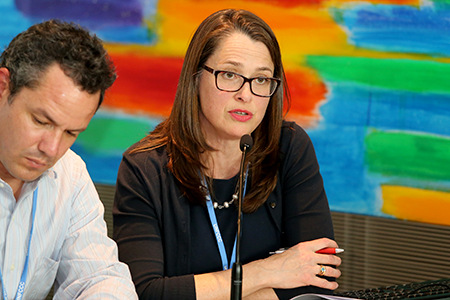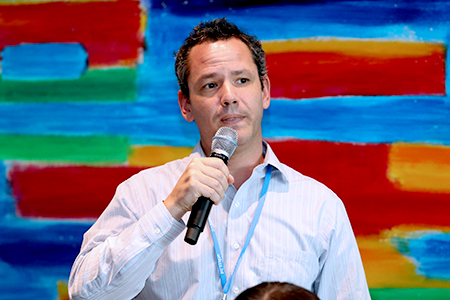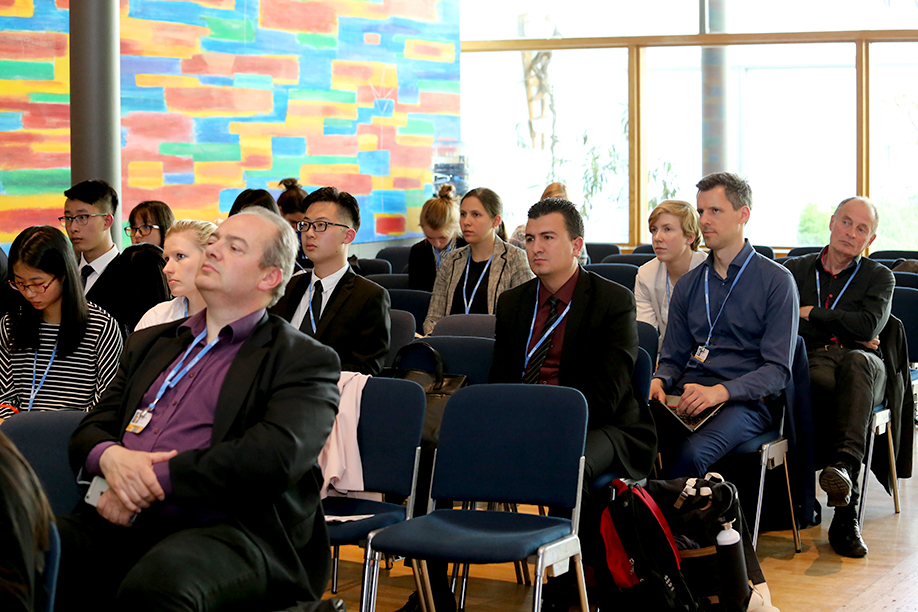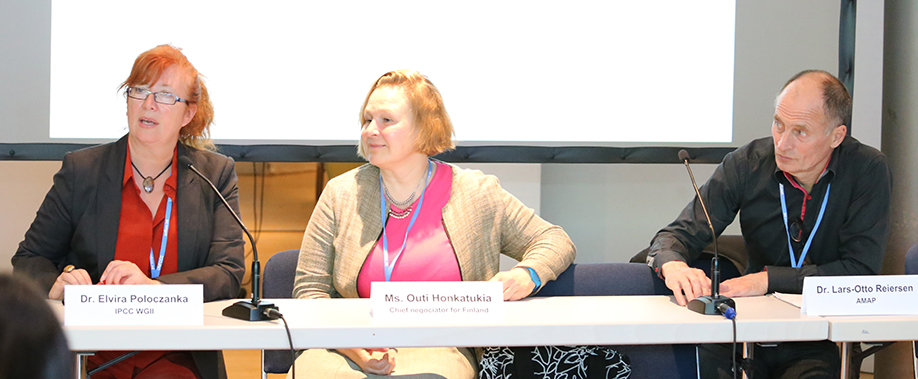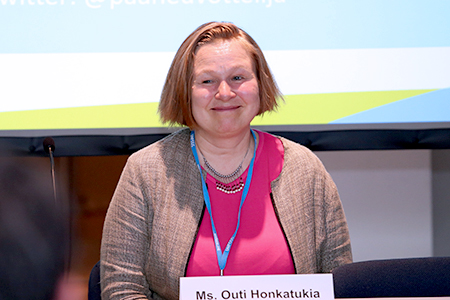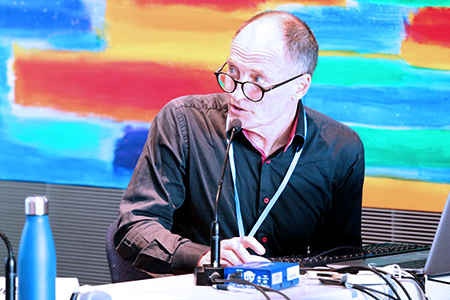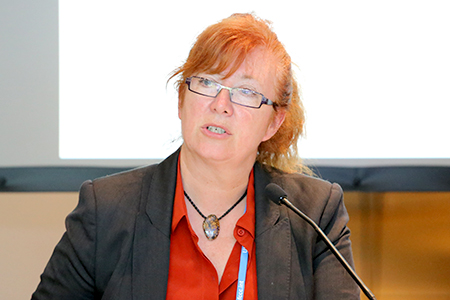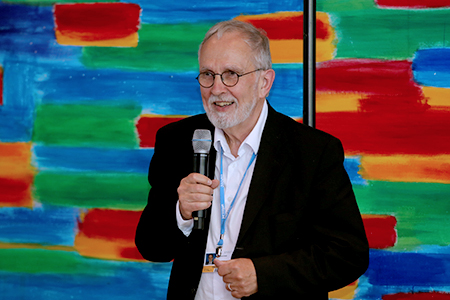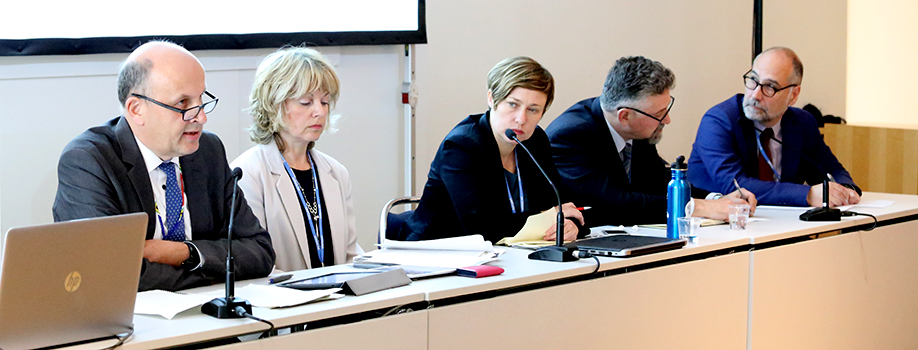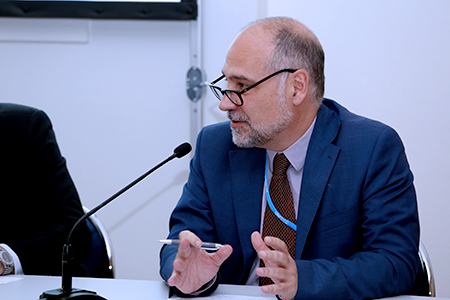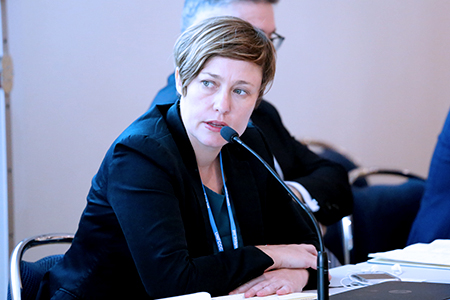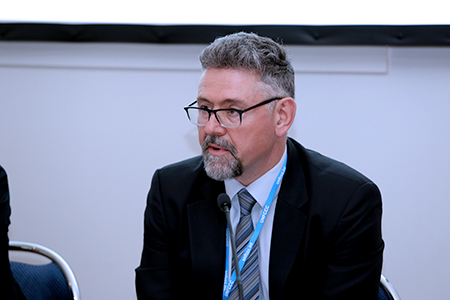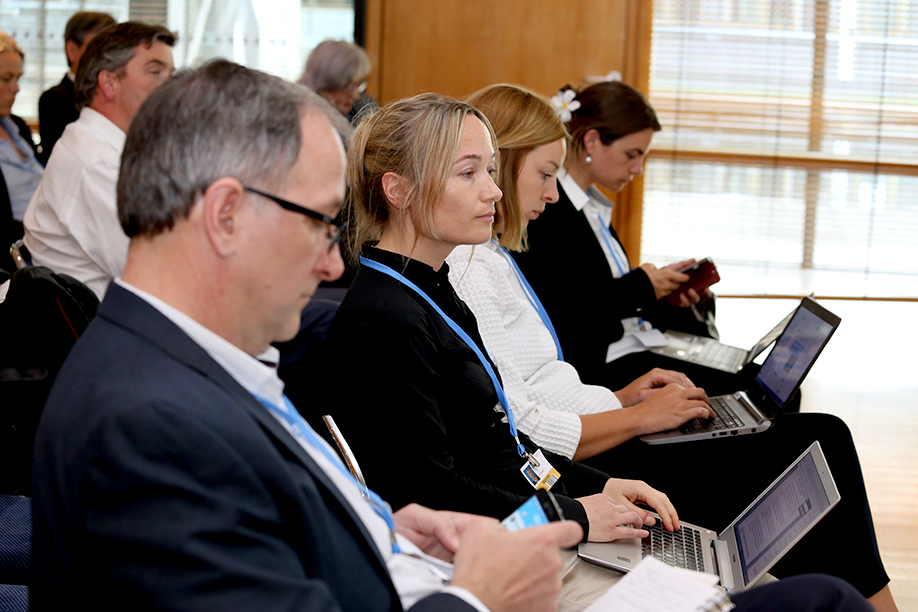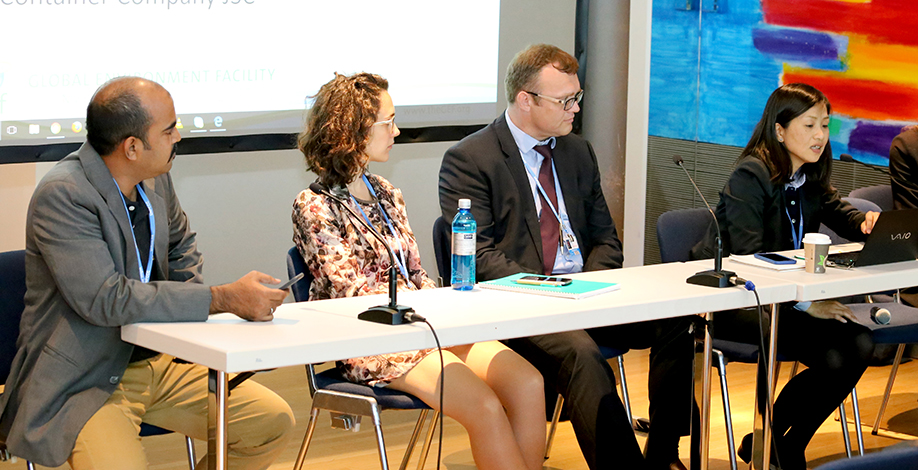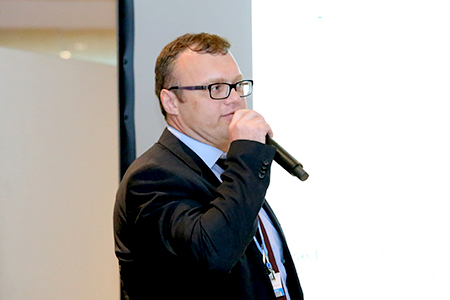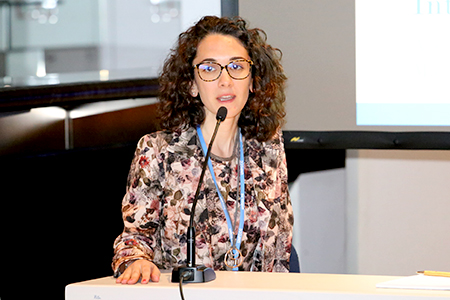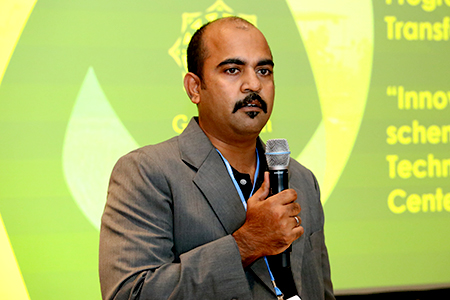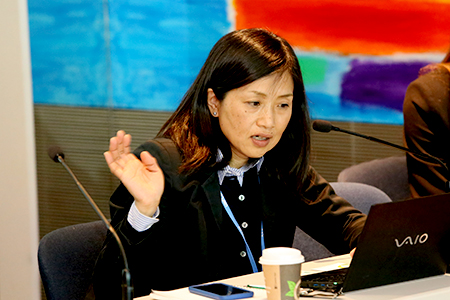Summary
The following side events were covered by ENBOTS on Monday, 15 May 2017:
- Ecosystems and Ecosystem-Based Adaptation: Advancing Action through Knowledge
- Achievements of the Consultative Group of Experts and Success Stories of National Communications and Biennial Update Reports from Developing Countries
- Climate and Development Benefits of Black Carbon Mitigation
- Arctic Council Ministerial and the Future of the Arctic under the Paris Agreement
- Integrating Climate Risk into the Finance Sector
- Poznan Strategic Programme on Technology Transfer
IISD Reporting Services, through its Earth Negotiations Bulletin on the Side (ENBOTS) Meeting Coverage, is providing daily web coverage of selected side events at the Bonn Climate Change Conference, May 2017.
Photos by IISD/ENB | Angeles Estrada Vigil
For photo reprint permissions, please follow instructions at our Attribution Regulations for Meeting Photo Usage Page
Ecosystems and Ecosystem-Based Adaptation: Advancing Action through Knowledge
Presented by the Nairobi Work Programme (NWP), the Least Developed Countries Expert Group (LEG) and Friends of Ecosystem-based Adaptation (FEBA)
This session, moderated by Musonda Mumba, UN Environment, centered on the role of healthy ecosystems in helping people to adapt to climate change. Participants discussed building climate resilience of ecosystems, and facilitating the integration of ecosystem-based adaptation (EbA) approaches in national development plans.
Tibor Schaffhauser, Subsidiary Body for Scientific and Technological Advice (SBSTA) Vice-Chair, on behalf of Carlos Fuller, SBSTA Chair, welcomed the NWP as “a knowledge-for-action network for climate resilience.” He invited NWP partners to pledge actions under the Programme.
Ali Raza Rizvi, the International Union for the Conservation of Nature (IUCN)/FEBA Secretariat, presented on a recent synthesis paper on ecosystems and EbA prepared under the NWP. Among key messages, he identified: the need for due diligence in all EbA interventions to avoid maladaptation; potential synergies between adaptation, mitigation and disaster risk reduction (DRR) offered by EbA; and the need to link Paris Agreement implementation with the Sustainable Development Goals (SDGs).
Angela Andrade-Pérez, Chair, IUCN Commission on Ecosystem Management (CEM), underscored that EbA is often the best solution to address climate change impacts as it provides co-benefits, creates jobs and avoids maladaptation. She noted that this approach should be applied in conjunction with other solutions, and that “soft” measures, such as communication, education and capacity building, are key for successful implementation.
Paul Desanker, UN Framework Convention on Climate Change (UNFCCC) Secretariat, highlighted work by the LEG and partners to explore implementation of the SDGs through National Adaptation Plans (NAPs), and by the Subsidiary Body for Implementation to assess progress in meeting the NAPs’ objectives.
Ronald Jumeau, Ambassador for Climate Change and Small Island Developing State (SIDS) Issues, Seychelles, discussed his country’s intention to convert 30% of its Exclusive Economic Zone into Marine Protected Areas, contributing to marine conservation and EbA. He highlighted the pioneering of innovative funding mechanisms to implement this project, including a “debt swap” with the Paris Club, South Africa and other partners, and stressed the project’s emphasis on stakeholder participation.
Paul Mafabi, Ministry of Water and Environment, Uganda, addressed efforts to enhance resilience of ecosystems in the Mount Elgon region in Uganda. Among lessons learned, he noted the need for: sustained engagement; benefits to flow to communities; and collective ownership.
Ninel Escobar Montecinos, World Wide Fund for Nature (WWF), Mexico, shared experiences with the implementation of an integrated system of water reserves as an early adaptation strategy in Mexico, which aims to cover 356 river basins by 2018. She highlighted almost a million local beneficiaries from this work thus far.
In the ensuing discussion, participants discussed, inter alia, the need for “hybrid” solutions with benefits for the climate, poverty reduction and communities, and experiences with Saint Lucia’s sustainable financing mechanism. Among different tools and platforms for promoting EbA, participants highlighted: tools provided by the UN Environment World Conservation Monitoring Centre for addressing different ecosystem types; a Convention on Biological Diversity synthesis report on ecosystem-based approaches to climate change adaptation and DRR; the German Government’s ‘Mainstreaming EbA’ project; Partners for Resilience; and IUCN’s work on understanding legal and policy frameworks that support the uptake of EbA.
(L-R): Ali Raza Rizvi, IUCN/FEBA Secretariat; Paul Desanker, UNFCCC Secretariat; Angela Andrade-Pérez, Chair, IUCN CEM; and Musonda Mumba, UN Environment
Ali Raza Rizvi, IUCN/FEBA Secretariat (right), stressed that poverty reduction is critical to successful adaptation.
Angela Andrade-Pérez, IUCN CEM (left),, highlighted ecosystems’ vital role in resilience, but warned that their capacity to deliver services is affected by climate change.
(L-R): Paul Mafabi, Ministry of Water and Environment, Uganda; Ronald Jumeau, Ambassador for Climate Change and SIDS Issues, Seychelles; Musonda Mumba, UN Environment; and Ninel Escobar Montecinos, WWF Mexico
Paul Desanker, UNFCCC Secretariat, invited participants to reflect on how best to prioritize resources to meet the requirements of priority ecosystems.
Musonda Mumba, UN Environment, moderated the event.
Paul Mafabi, Ministry of Water and Environment, Uganda, underscored that participatory planning is key for ensuring ownership and sustainability.
Ninel Escobar Montecinos, WWF Mexico, stressed preserving water is “a race against time.”
Contact:
- Rojina Manandhar | rmanandhar@unfccc.int
More Information:
- http://unfccc.int/resource/docs/2017/sbsta/eng/03.pdf
- https://www.surveymonkey.de/r/ecosystemsNAPs
- http://www4.unfccc.int/sites/NWP/News/Pages/ecosystems-side-event-2.aspx
Achievements of the Consultative Group of Experts and Success Stories of National Communications and Biennial Update Reports from Developing CountriesPresented by the Secretariat of the UN Framework Convention on Climate Change (UNFCCC)
This side event discussed the achievements of the Consultative Group of Experts (CGE) on National Communications (NCs) in assisting developing countries in implementing the UNFCCC monitoring, reporting and verification (MRV) and transparency framework. Dominique Revet, UNFCCC Secretariat, moderated the event.
Stephen Mutua Kinguyu, CGE member, Kenya, reported that the CGE’s mandate was renewed at the 19th session of the Conference of the Parties to the UNFCCC (COP 19) for the 2014-2018 period, highlighting its objective of improving the process and preparation of NCs and Biennial Update Reports (BURs) by developing countries by providing them with technical assistance and support. He highlighted five key strategic priorities of the CGE’s five-year programme, including: building developing countries’ capacity; enhancing the sustainability of the NC and BUR process, cooperation and collaboration with other global initiatives, and communication and outreach; and ensuring availability of resources. Among the CGE’s capacity-building activities, Kinguyu noted: developing tools and guidance materials; capacity-building workshops; developing collaboration with key global initiatives; monthly webinar series on vulnerability and adaptation, mitigation, national greenhouse gas (GHG) inventories and support; and outreach activities. He further indicated that CGE training materials are easily downloadable on the UNFCCC CGE website, which also provides access to free e-learning courses, and that CGE training materials are also available in French and Spanish.
Kok Seng Yap, Malaysia, shared lessons learned on overcoming challenges faced in preparing his country’s national reports. He outlined key findings of Malaysia’s BUR submitted on 3 March 2016, including that: effective institutional arrangements based on built ownership and a robust MRV system necessitate adjustments; good understanding of UNFCCC decisions and the Intergovernmental Panel on Climate Change (IPCC) guidelines increases transparency of reporting; and the international consultation and analysis process enhances understanding of reporting requirements for future improvements. Regarding key challenges related to mitigation actions, he noted: operationalizing a robust MRV system; lack of information for quantification and reporting; and quantification of needs. Among GHG inventory-related challenges, he highlighted limited availability of activity data according to IPCC guidelines, and country-specific emission factors. He said these challenges could be addressed through continuous engagement with formal and informal stakeholders, trust-building and training.
In the ensuing discussion, participants addressed, inter alia: participants’ selection process in CGE training sessions; advantages of building national institutional capacity over short-term consultants’ engagement; the role of the CGE in Paris Agreement implementation and in building relationships with the Paris Committee on Capacity-building and the Capacity-building Initiative for Transparency; and the impact of NC and BUR preparation on future country policies.
(L-R): Bhava Dhungana, UNFCCC Secretariat; Dominique Revet, UNFCCC Secretariat; Stephen Mutua Kinguyu, CGE member, Kenya; and Kok Seng Yap, Malaysia
Stephen Mutua Kinguyu, CGE member, Kenya, invited views from parties on “what the CGE could do for them it is not already doing.”
Dominique Revet, UNFCCC Secretariat, said the UNFCCC Secretariat has supplementary funding for assisting developing countries with workshop participation.
Contact:
-
Bhava Dhungana (Organizer) | BDhungana@unfccc.int
Dominique Revet (Moderator) | drevet@unfccc.int
More Information:
Climate and Development Benefits of Black Carbon MitigationPresented by the Institute for Advanced Sustainability Studies (IASS), the Climate and Clean Air Coalition (CCAC) and the Governments of Canada, Chile and Mexico
This side event highlighted the impacts of black carbon on climate and health, and discussed the scientific rationale for countries to include black carbon as a regulated emission in national and local air quality regulations and standards. Nathan Borgford-Powell, CCAC, moderated the event.
Noting that black carbon is the second most important warming agent in the atmosphere, Mark Lawrence, IASS, highlighted climate and health reasons to mitigate emissions of short-lived climate pollutants (SLCPs). He stressed that fast action to mitigate SLCPs will: reduce near-term warming; contribute to the 2°C above preindustrial levels target; reduce the need for climate adaptation; and, while saving lives, improve health and productivity.
Borgford-Powell concentrated on metrics for evaluating climate benefits and co-benefits of SLCP measures. He outlined the applications of these metrics, including: quantification of impacts and benefits of SLCP mitigation; standardization of reporting activities; measurement of progress towards long-term climate goals; and comparison between climate pollutants. Highlighting a recent CCAC Scientific Advisory Panel Expert Workshop on metrics, Borgford-Powell called for a “near-term temperature metric” for SLCPs that complements long-term temperature targets.
Participating virtually, Drew Shindell, Duke University, described climate change as “both a short-term and a long-term problem.” He stressed that the long-term transition to a low-carbon society does not consider the short-term health and climate impacts of pollutants other than carbon, including: emissions released through burning waste; leaked methane from waste management; and biomass- and bioenergy-related emissions.
Maria Amparo Martínez, Mexico, underscored that Mexican urban areas have air pollution levels above what is considered healthy by the World Health Organization. Reporting that Mexico’s 2013 black carbon emission inventory estimated 125,000 tons of black carbon emissions annually, Martínez highlighted an interinstitutional black carbon monitoring network and other strategic actions planned in the country’s “megalopolis” region around Mexico City.
Felipe Osses, Chile, emphasized that Chile’s Nationally Determined Contribution (NDC) includes actions to reduce SLCPs through climate-related instruments and environmental management. He highlighted his country’s mitigation actions to reduce SLCPs under its ‘Climate Change Action Plan 2017-2022,’ including: development of the ‘Climate, Clean Air and Capacity Building’ programme; assessment of black carbon and CO2 reduction potential through green freight; elaboration, updating and integration of inventories of greenhouse gas (GHG) emissions and SLCPs; a strategy for atmospheric decontamination; and hydrofluorocarbon replacement actions.
Catherine Stewart, Canada, underlined Canada’s recognition of the important role SLCPs play in meeting long-term temperature targets. She highlighted her country’s efforts to mitigate SLCPs, including through: its ‘mid-century, long-term low-GHG development strategy;’ the Pan-Canadian Framework for Clean Growth and Climate Change; and the implementation of air pollution regulations. Stewart said that Canada faces a “particular challenge” in reducing reliance on diesel for electricity and heating in Northern, remote and indigenous communities.
During the ensuing discussion, participants addressed, inter alia: reduction of wildfires as a form of mitigation of black carbon and co-pollutants; inclusion of black carbon in the measurement of national emissions; and expansion of the CCAC.
(L-R): Catherine Stewart, Canada; Felipe Osses, Chile; and Maria Amparo Martínez, Mexico
Mark Lawrence, IASS, underscored that outdoor particulate matter causes approximately 4 million premature deaths annually worldwide.
Nathan Borgford-Powell, CCAC, said the CCAC will “road test” proposed near-term climate metrics with interested countries and institutions.
Catherine Stewart, Canada, stated that Canada’s investments in clean energy will result in reduced black carbon emissions.
Felipe Osses, Chile, outlined Chile’s “integral policy-making approach” to reducing SLCPs emissions.
Contact:
-
Kathleen Mar | Kathleen.mar@iass-potsdam.de
Erin Silsbe | erin.silsbe@canada.ca
More Information:
-
http://www.iass-potsdam.de/en/institute-advanced-sustainability-studies
http://www.ccacoalition.org/en
Arctic Council Ministerial and the Future of the Arctic under the Paris AgreementPresented by the International Cryosphere Climate Initiative (ICCI)
This side event addressed climate outcomes of the 10th Arctic Council Ministerial held in Fairbanks, Alaska, US, from 10-11 May 2017, and the role of the Paris Agreement in preserving the Arctic’s role in the climate system. Participants discussed the findings of the 2017 climate impact assessment by the Arctic Council titled ‘Snow, Water, Ice and Permafrost in the Arctic’ (SWIPA2), and their implications for the 2018 facilitative dialogue and the global stocktake envisioned under the Paris Agreement. Svante Bodin, Director, ICCI-Europe, moderated the event.
Lars-Otto Reiersen, Arctic Monitoring and Assessment Programme (AMAP), Arctic Council, presented on SWIPA2. Among the report’s key findings, he noted: record high Arctic temperatures in the last decade; that by mid- and late 2100 the Arctic will be “very different”; and urgent mitigation action can stabilize parts of the Arctic towards the end of the 21st century. Underscoring the Arctic Council Fairbanks Declaration 2017, he identified the AMAP Working Group’s recommendations, including early, ambitious and full implementation of the Paris Agreement, and prioritization of research to enhance certainty in predictions.
Elvira Poloczanska, Intergovernmental Panel on Climate Change (IPCC) Working Group II (WG II) Technical Support Unit (TSU), updated participants on progress on the preparation of the IPCC ‘Special Report on the Ocean and Cryosphere in a Changing Climate’ (SROCC) to be finalized in September 2019.
Outi Honkatukia, Finland, outlined Finland’s four priorities for its 2017-2019 chairmanship of the Arctic Council: environmental protection, including biodiversity conservation, pollution prevention, and climate change mitigation and adaptation; connectivity; meteorological cooperation, including on intensifying monitoring and filling geographical gaps in data collection; and education. Honkatukia underscored that sustainable development is “at the core of the Arctic Council’s mandate,” and called for exploring how the 2030 Agenda for Sustainable Development framework can be used for Arctic cooperation for the benefit of humans and nature.
Svante Bodin addressed the implications of the Arctic “passing irreversible thresholds” for the 2018 facilitative dialogue, and highlighted the need for new and additional measures. Linking the Arctic cryosphere with the Sustainable Development Goals, he stressed the need to reduce cryosphere climate change in the near term, reduce air pollution and feed a growing population through addressing Short-Lived Climate Pollutants. Bodin underscored that the only way to prevent irreversible changes in the Arctic is to accelerate all possible mitigation measures quickly and decisively “never to reach these temperatures at all,” as “a 2°C world is a 5°C Arctic.” He said that the choice for the 2018 stocktake is between Arctic-preserving mitigation or extreme adaptation and geoengineering.
Participants then viewed an intervention made during the Arctic Council Ministerial by Wallström, Minister for Foreign Affairs, Sweden, who emphasized that “we have the knowledge, technology, money and capacity to save our planet.”
In the ensuing discussion, participants addressed, inter alia: methane release through the loss of permafrost; the need for a pamphlet “bringing science to the public” and associated communication challenges; the response of the negotiating and political communities to the situation in the Arctic and its global impacts; the irreversibility of changes in the Arctic; and civil society involvement and the role of intergenerational equity.
(L-R): Elvira Poloczanska, IPCC WG II TSU; Outi Honkatukia, Finland; and Lars-Otto Reiersen, AMAP, Arctic Council
Outi Honkatukia, Finland, said that “the Arctic is a global issue; you feel impacts not just in Greenland, but also in New York and Florida.”
Lars-Otto Reiersen, AMAP, Arctic Council, described the Arctic as the “barometer of the globe.”
Participants viewed an intervention made during the 10th Arctic Council Ministerial by Margot Wallström, Minister for Foreign Affairs, Sweden, who said Sweden will be carbon-neutral by 2045.
Elvira Poloczanska, IPCC WG II TSU, indicated that the SROCC will address, inter alia: high mountain areas; the polar regions; and sea-level rise and implications for low lying islands, coasts and communities.
Warning that “what happens in the Arctic doesn’t stay in the Arctic,” Svante Bodin, Director, ICCI-Europe, highlighted the disproportionate impacts on poor populations.
Contact:
-
Pamela Pearson | pam@iccinet.org
Svante Bodin (Moderator) | svante@iccinet.org
More Information:
Integrating Climate Risk into the Finance SectorPresented by the Carbon Disclosure Project (CDP) Worldwide, the World Business Council for Sustainable Development (WBCSD) and the World Wide Fund for Nature (WWF)
This session focused on the recommendations of the Financial Stability Board’s (FSB) Task Force on Climate-related Financial Disclosures (TCFD) as a tool to manage climate risks. It was moderated by Nicolette Bartlett, CDP.
Norbert Gorißen, Federal Ministry for the Environment, Nature Conservation, Building and Nuclear Safety (BMUB), Germany, welcomed the TCFD’s recommendations as “a very important piece of work,” noting they will showcase how financial markets can identify risk and barriers to shift finance closer to climate-related investments.
Underscoring “there is lots of evidence of real-life action companies are taking,” Lois Guthrie, WBCSD and Founding Director, Climate Disclosure Standards Board (CDSB), noted that investors still find it difficult to act on information because of a lack of standards and comparability. She called for “more infrastructure” to support commitments and actions towards improved policy making.
Ed Wells, the Hong Kong and Shanghai Banking Corporation (HSBC), said the TCFD’s recommendations offer a framework to channel money in the “right direction” and ensure the right sectors are being supported. Suggesting that a mandatory legislative response “will take a long time,” he stressed that “the private sector can drive this soon.”
Santiago Lorenzo, WWF, highlighted that climate change is “on top of our work’s systemic risk” and said the same applies to financial institutions, whose core businesses will be affected by climate change. He highlighted the TCFD’s efforts as vital for ensuring that good investment decisions are taken.
In the ensuing discussion, participants raised the question of how to address “incumbents” who benefit from short-term investments that are destructive for the planet. They highlighted, inter alia: the importance of coherence and transparency for guiding good investments; the potential of multilateral development banks cooperating in this area; and the role of science in enhancing transparency. France’s ‘Article 173’ on climate risk reporting, the UK’s Public Services (Social Value) Act and the 2° Investing Initiative were lauded as positive examples and developments. Participants also highlighted that “we are talking about the trillions here” and questioned the prospects of “getting where we need to be” without a meaningful carbon price.
L-R: Norbert Gorißen, BMUB, Germany; Lois Guthrie, WBCSD and Founding Director, CDSB; Nicolette Bartlett, CDP; Ed Wells, HSBC; and Santiago Lorenzo, WWF
Lois Guthrie, WBCSD and Founding Director, CDSB, noted that current climate change activities are so fragmented that they do not “add up to a coherent whole.”
Santiago Lorenzo, WWF, emphasized that ecosystems and the economy will benefit significantly from “preserving the world we live in right now.”
Nicolette Bartlett, CDP, moderated the event.
Ed Wells, HSBC, observed that “markets need good quality information to avoid mispricing of risk and misallocation of resources.”
Contact:
-
Shirin Reuvers | shirin.reuvers@cdp.net
Elise Buckle | buckle@wbcsd.org
Mandy Woods | mwoods@wwf.org.za
More Information:
Poznan Strategic Programme on Technology TransferPresented by the Global Environment Facility (GEF)
In this side event, panelists shared experiences and lessons learned from projects supported under the Poznan strategic programme (PSP) on technology transfer. They focused on the knowledge and networks of regional development banks, and provided inputs to an update of the evaluation of the PSP scheduled for 2017. Masako Ogawa, GEF, moderated the event.
Noting that sustainable investing is “increasingly mainstream” for multilateral development banks (MDBs), Duarte da Silva, Asia Climate Partners (ACP), pointed to significant for partnerships with institutions that have common goals and complementary capabilities to MDBs. He identified a “mismatch” between supply of, and demand for, environmental finance investments, where investor interest is estimated to be US$620 billion but current market size amounts to only US$120 billion. Da Silva outlined the ACP’s ‘Climate Public-Private Partnership Fund’ concept, underscoring that the Fund mobilizes capital at scale from global public and private sector investors.
Abhilash Thirupathy, Gold Farm, identified key barriers to the development of renewable energy in India, including: limited access to venture capital funding; and the lack of a long-term view of capacity building. He highlighted Gold Farm’s partnership with the PSP and noted key achievements, including: installation of 750 off-grid solar pumps across five states in India; conversion of 1,500 hectares of barren land to cultivable land; and annual revenue of US$2.5 million in the last financial year.
Astrid Motta, European Bank for Reconstruction and Development (EBRD), highlighted EBRD’s Finance and Technology Transfer Centre for Climate Change (FINTECC) programme, detailing its support for companies to implement advanced climate technologies that reduce greenhouse gas emissions and increase climate resilience by providing grants and technical assistance. She said that the EBRD has signed 29 transactions to date that include a FINTECC grant component, with incentives worth US$7.3 million supporting US$100 million in green incentives. Motta provided three examples of EBRD FINTECC projects: reduction of the carbon footprint of plastic toy production in Belarus; energy efficient building management systems in hospitals in Georgia; and modernization of lightweight glass manufacturing in Moldova.
Detailing an EBRD-financed project in Moldova, Boris Crivoi, JV Glass Container Company JSC, highlighted energy saving processes that were implemented in the glass manufacturing process with FINTECC support. He reported a reduction of 9-9.5% of total energy consumption as well as reduced CO2 emissions per unit.
Elfriede-Anna More, Technology Executive Committee (TEC), outlined TEC activities on climate technology financing, including: preparation of policy briefs on key technology issues; delivery of key messages and recommendations to the Conference of the Parties to the UN Framework Convention on Climate Change on policies for climate technology actions; and stimulation of cooperation between key national and international donors. She introduced the TEC brief ‘Enhancing Access to Climate Technology Financing,’ pointing to a key finding that climate technology requires a combination of “long lasting, loud and legal policy incentives,” market facilitation and public finance.
During the ensuing discussion, participants addressed, inter alia: linkages between solar technology and irrigation in India; replicability and diffusion of technology at the regional level; and monitoring and evaluation of the FINTECC programme and investment scheme.
(L-R): Abhilash Thirupathy, Gold Farm; Astrid Motta, EBRD; Boris Crivoi, JV Glass Container Company JSC; and Masako Ogawa, GEF
Boris Crivoi, JV Glass Container Company JSC, said that investing in green technology fosters “parallel” climate benefits.
Astrid Motta, EBRD, highlighted 1,200 “green financing” projects supported by the EBRD from 2006-2016.
Abhilash Thirupathy, Gold Farm, highlighted providing employment to 120 people among his company's key achievements.
Masako Ogawa, GEF, moderated the event.
Contact:
-
Masako Ogawa | mogawa2@thegef.org
